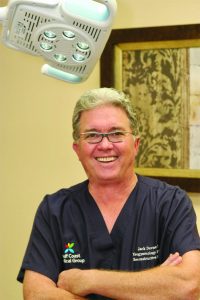
An unfortunate fact of later life for many women who have experienced childbirth is “pelvic prolapse,” or a hernia of the vagina.
The number one cause is childbearing with vaginal delivery.
“Vaginal delivery can traumatize the connective tissues that hold the vagina in place, and these tissues can weaken over time. Eventually, that damage can result in pelvic pressure or pain, urinary or fecal incontinence, pain during intercourse, and other symptoms,” said John Devine II, M.D., FACOG. “Fortunately, today we can safely and successfully resolve the problem with minimally invasive vaginal surgery.”
Dr. Devine is a urogynecologist with the Gulf Coast Medical Group Women’s Health & Wellness practice. A board-certified gynecologist, Dr. Devine is also fellowship-trained in urogynecology and female pelvic reconstructive surgery, which he performs at Venice Regional Bayfront Health. This specialized, three-
year fellowship training differentiates his expertise from general gynecologists and urologists.
“Hernias, or prolapses, account for over 20 percent of the major gynecologic surgeries in developed countries,” said Dr. Devine. There is an 11 percent lifetime risk that a woman will require a surgery for prolapse or urinary incontinence.
“There are four specific vaginal hernias a woman can have. You may have one or all four,” said Dr. Devine. “We must identify each and any that exist, because if you don’t correct all of them, problems will persist and may even get worse.”
Identifying and treating the different hernias is where a urogynecologist comes in. This specialty combines extra training in both urinary and gynecological conditions, which are often interrelated.
The four vaginal hernias are:
• Cystocele – A hernia at the front wall of the vagina where the bladder sits.
• Enterocele – A hernia at the top part of the vagina where the cervix and uterus attach. If the woman still has a uterus, it can drop. If the uterus has been removed (hysterectomy), the intestines can drop.
• Rectocele – A hernia at the back wall of the vagina between the rectum and vagina.
• Urethral hypermobility – Loss of support near the opening of the vagina under the urethra, which can cause urinary incontinence or leaking when the woman coughs or sneezes.
All can be corrected vaginally with minimally invasive surgical techniques. Shoring up weakened tissue in the pelvic area requires adding structural support, Dr. Devine said.
“There is no connective tissue (tendons, fascia, etc.) in the pelvic area or vagina,” he said. “When the tissue that holds the organs in place is torn or weakened due to the trauma of childbirth and the aging process, we need to provide new support.”
There are currently three types of support that surgeons use: synthetic mesh, human dermis or skin, and human connective tissue or fascia.
The synthetic mesh has been associated with complications, and the Food & Drug Administration now warns against its use.
Human dermis or skin from a tissue bank is a natural solution, but it can result in thick and irregular healing.
Dr. Devine was one of the first, and continues to be one of the only, physicians in the country who exclusively uses human connective tissue or fascia for repairs.
“This is native connective tissue – the same tissue that we have in our body that holds us together,” he said. “Using human fascia for the repair creates a matrix into which the body lays scar tissue, essentially creating a native connective tissue that strengthens the area and gives a better repair.”
Regardless of the type or types of vaginal hernias repaired during the procedure, most patients stay in the hospital only overnight and return to normal activities within 12 weeks.
“With the new, minimally invasive surgical techniques performed by a surgeon trained in pelvic reconstructive surgery, patients are more likely to have great outcomes.” Dr. Devine said.
For more information on women’s health, including vaginal hernias, call 941-207-5330.
Top 3 Questions to Ask
Before Pelvic Surgery
1. Is the surgeon fellowship-trained in female pelvic surgery?
2. What is the surgeon’s experience, complication rate and failure rate?
3. What type of material will be used for the repair (fascia, dermis, mesh, or a combination)? The doctor must explain noted complications of all materials used for repairs.








